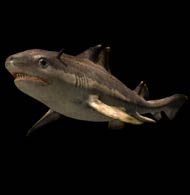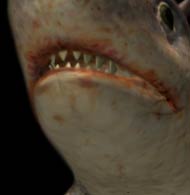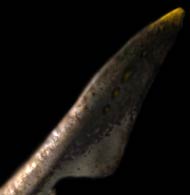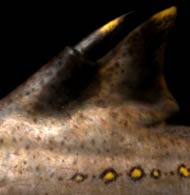
Hybodus was an early shark. Judging by the size of its teeth Hybodus was about 2 metres long and almost certainly had the typical streamlined shape that all sharks have had since their first appearance in the Devonian period, over 360 million years ago. Its jaws housed two types of teeth, reflecting a varied diet. One set was sharp, suitable for seizing slippery prey like fish and squid. Its other teeth were flat and strong, for crushing the casings of shelled animals like molluscs and sea urchins.
The little that palaeontologists do know about prehistoric sharks is mainly gleaned from their teeth, which are constantly being shed and replaced through its life. They are the only parts of its body that normally fossilise, and are relatively common. They are very abundant at some locations, and have been found in marine deposits of Jurassic age across the world.
Shark skeletons are made of cartilage not bone, and so do not fossilize well. However, there are rare fossils of its spiny dorsal fin. The fin might have been used as a means of defence - if another sea creature tried to swallow the shark, it could raise its dorsal fin to make this a difficult, unpleasant job.
 Hybodus was an early shark. Judging by the size of its teeth Hybodus was about 2 metres long and almost certainly had the typical streamlined shape that all sharks have had since their first appearance in the Devonian period, over 360 million years ago. Its jaws housed two types of teeth, reflecting a varied diet. One set was sharp, suitable for seizing slippery prey like fish and squid. Its other teeth were flat and strong, for crushing the casings of shelled animals like molluscs and sea urchins.
Hybodus was an early shark. Judging by the size of its teeth Hybodus was about 2 metres long and almost certainly had the typical streamlined shape that all sharks have had since their first appearance in the Devonian period, over 360 million years ago. Its jaws housed two types of teeth, reflecting a varied diet. One set was sharp, suitable for seizing slippery prey like fish and squid. Its other teeth were flat and strong, for crushing the casings of shelled animals like molluscs and sea urchins.


